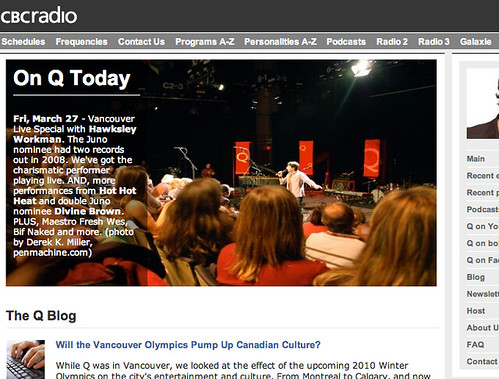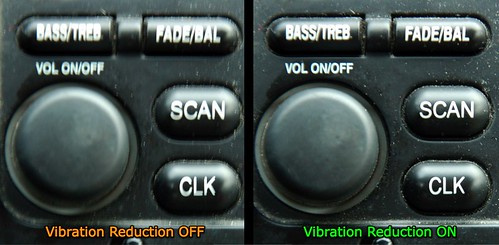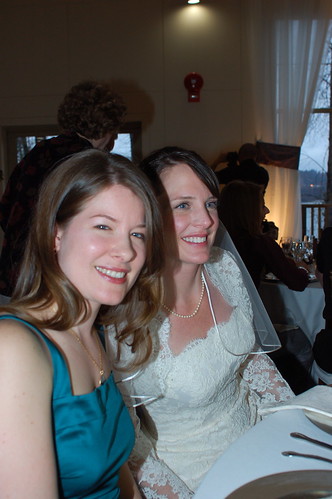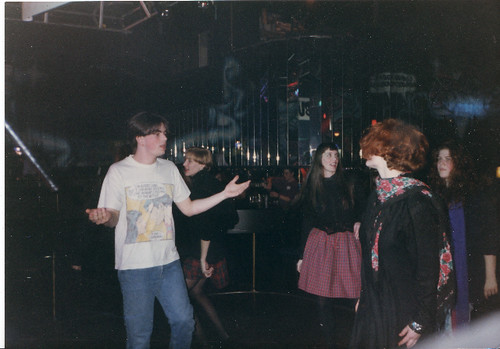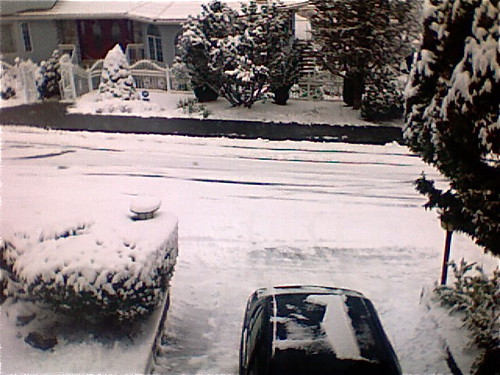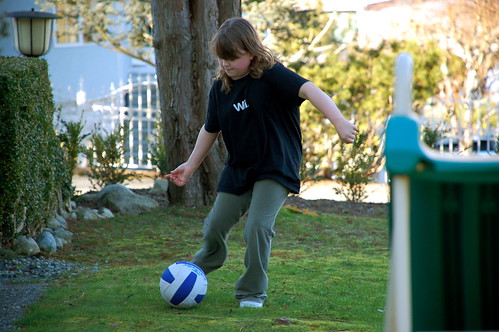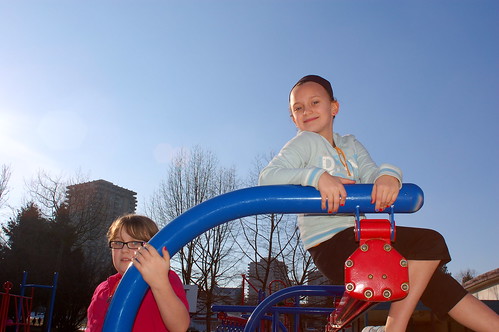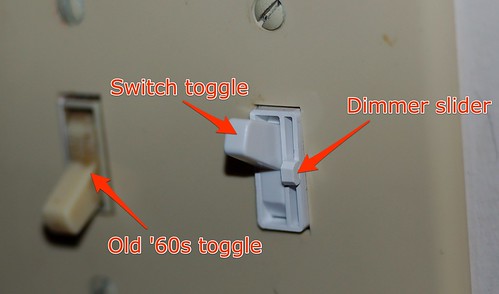Penmachine
31 March 2009
IHR and LGL posted for March
My wife Air and her co-host KA have posted Lip Gloss and Laptops #132, and my co-host Dave and I have published Inside Home Recording #69 (dude).
The shows cover GarageBand '09, Simply Ageless Foundation, different types of audio delay, Barry M Cosmetics, too much Nickelback, and Rejuvelash Natural Declumping Lash Exhilarator. I'll let you guess which podcast addresses which products.
Labels: insidehomerecording, lipglossandlaptops, podcast
30 March 2009
Juno night
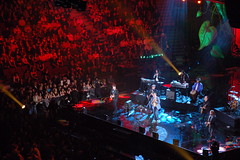 Last night my wife and I went to the Juno Awards (Canada's English-language music industry awards, like the Grammys) at the GM Place hockey arena here in Vancouver. We were waaaay up in the rafters, but still had a decent view. However, one of the ushers told me the lens on my SLR camera was "too big"—you know what they say about the size of man's lens—so I had to be surreptitous about it, and thus didn't get too many photos.
Last night my wife and I went to the Juno Awards (Canada's English-language music industry awards, like the Grammys) at the GM Place hockey arena here in Vancouver. We were waaaay up in the rafters, but still had a decent view. However, one of the ushers told me the lens on my SLR camera was "too big"—you know what they say about the size of man's lens—so I had to be surreptitous about it, and thus didn't get too many photos.
There was lots of music, as you would expect. But the acts I liked best surprised me. Dallas Green's City and Colour (with guest Gord Downie of the Tragically Hip) topped my list, even though I'd never heard of Green before. I'm a musical oldster, you see. Bryan Adams and Kathleen Edwards were also remarkable, singing without a backing band and turning out a marvelously affecting acoustic performance of "Walk On By," with strong harmonies. 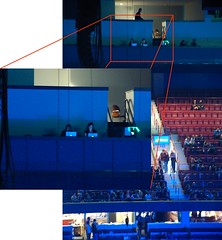 And Divine Brown again showed the amazing voice I'd heard a few nights before—she needs to get out from the overdone dance production on her album, I think.
And Divine Brown again showed the amazing voice I'd heard a few nights before—she needs to get out from the overdone dance production on her album, I think.
We also spotted our live-blogging pals Miss604 and Arieanna (who had an awesome announcement the next day) in the rafters across from us. I snapped a picture before I got busted by the usher.
Since it was broadcast live across the country, the Juno ceremony started early (5 p.m.), and was over promptly at 7. We were home before the sun even went down, which is often just as well for us these days.
P.S. Yes, Nickelback started the show with a song called "Something in Your Mouth." And pyro effects coming from stage props designed to look like giant chrome exhaust pipes.
P.P.S. Does anyone know who buys all those Nickelback albums?
Labels: band, blog, music, television, vancouver
29 March 2009
Long lost friends
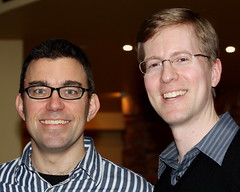 In 1974, on my first day of kindergarten, I made some friends. One of my earliest memories of school that year was three of us working on an art project. Rand, one of my friends, had a huge (huge for five-year-olds, at least) bottle of white glue turned upside down, but like a ketchup bottle, it was jammed.
In 1974, on my first day of kindergarten, I made some friends. One of my earliest memories of school that year was three of us working on an art project. Rand, one of my friends, had a huge (huge for five-year-olds, at least) bottle of white glue turned upside down, but like a ketchup bottle, it was jammed.
Brent, my other friend, sang out, "There's no more gluuuuuue!" And then a huge glop of it fell onto the paper, completely covering up what we were working on.
I stayed friends with Rand and Brent for many years afterward. When Brent's family took a year away to go sailing around the Caribbean, we borrowed their TRS-80 Model I personal computer, the first one we had in our house. Rand and I spent hours at each other's homes, or with his family at their cabin on Keats Island, playing with Star Wars action figures.
Even when Rand changed to a West Side private school and his family moved out that way, we kept in touch, and a couple of years later I went to that school too. We lost touch with Brent slowly after that, though he was in my Boy Scout troop until 1982, and I have seen him from time to time in the interim.
Rand and I once tried making smoke bombs at his place, and drying them in the microwave. Not a smart move. We had to open all the windows and pull out the smoke alarm battery, hoping things would clear before his parents got home.
Eventually, he moved to yet another school and, as happens, we drifted away from one another. He emigrated to New York City almost 20 years ago, got married, and had a son. I stayed here in Vancouver, got married, and had two daughters. My daughters started kindergarten at the same school where Rand and I met a few years ago. They're still going there.
Recently Rand and I got in touch again on Facebook. He and his wife and son were in town last week to visit his family, and on Friday night my girls and I met them downtown for dinner. It was a short visit, but fun—the first time Rand and I had seen each other for more than 25 years. Long enough that he had time to grow taller than me.
We were both pretty big nerds back in the '70s and early '80s. Our nerdiness has mellowed, and it's also cooler to be geeky these days than it used to be. So we're different, yet not. Just like Vancouver.
Labels: friends, memories, newyork, school, vancouver
27 March 2009
My photo on the Q home page
After I took some pictures of the taping of CBC's "Q" last night, I let CBC know about them, and this morning, here was the result:
That's my photo as the headline picture on the "Q" home page. You can also listen to the podcast version (MP3 file) of the episode.
Labels: band, cbc, music, photography, podcast, radio, vancouver
26 March 2009
Being in the audience for Q
CBC Radio's "Q" is a national, Toronto-based, daily arts, culture, and entertainment show hosted by Jian Ghomeshi. For some reason I don't quite understand, I wasn't too fond of him before—I'd garnered a bad impression and it just stuck with me. (Maybe it was a Moxy Früvous hangover.)
Anyway, tonight my daughter M and I trotted down to the CBC building in Vancouver for a live-in-front-of-an-audience taping of "Q," to be broadcast on the radio tomorrow. The show has been in Vancouver all week before the Juno Awards (Canada's equivalent to the Grammys) on Sunday, which my wife and I will be attending. I took some photos:
Musical acts performing tonight included Hawksley Workman, Divine Brown, and Hot Hot Heat. Bif Naked also dropped in for an interview, as did Torquil Campbell of Stars. And I have to say, in person Ghomeshi is engaging, open, and personable. I think I've become a fan.
Labels: band, cbc, music, radio, vancouver
24 March 2009
I made a goofy little metal video
Paul Thurrott and Leo Laporte have used my tune "More Red Than Red" as theme music for their Windows Weekly podcast since 2006. But on their latest episode, they thought about maybe replacing it with the title track from the album "Enigma," by Microsoft's retired chief of Windows development (and longtime guitarist) Jim Allchin. So I tried to dissuade them at the Penmachine Podcast:
The "Turrican Van Halen" reference is part of the Windows Weekly show—it refers to the old Commodore 64/Atari/Amiga game "Turrican."
I made this available as Inside Home Recording TV Episode #5. You can also download it (H.264 video) or watch it at Viddler, Blip.tv, Facebook, YouTube, and Vimeo. Licensed for you to share and reuse, as long as you give me credit.
Labels: insidehomerecording, leolaporte, music, penmachinepodcast, podcast, video, windows
22 March 2009
Get 20% off my GarageBand video course
A few months ago I recorded a big series of more than 50 short instructional videos for the Quick Start to GarageBand course at MacVideoTraining.com, a new video training company co-founded by my former Inside Home Recording (IHR) podcast co-host Paul Garay. Some of their other training DVDs are available at lots of retailers throughout North America.
However, if you want a better deal, you need to do it online. You can buy my course, or one of several others from the company, with a 20% discount on any single video or bundle, through a new affiliate program at IHR. Just go to insidehomerecording.com/mvt and enter the coupon code ihr at checkout.
Labels: apple, education, insidehomerecording, music, podcast, recording
The feel of it
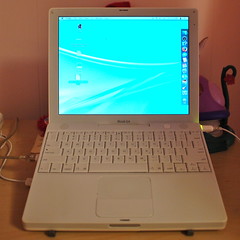 Men often obsess about our gadgets—computers, cameras, cars, fishing gear, barbecues, TVs, stereos, whatever. But too often, we get wrapped up in the stats and numbers, and forget about the feel of what we use. Not that it's unimportant, but frequently when we're researching a new purchase, we'll ignore it in favour of the specs, and only learn about the subjective experience of using the device later. Sometimes to our detriment.
Men often obsess about our gadgets—computers, cameras, cars, fishing gear, barbecues, TVs, stereos, whatever. But too often, we get wrapped up in the stats and numbers, and forget about the feel of what we use. Not that it's unimportant, but frequently when we're researching a new purchase, we'll ignore it in favour of the specs, and only learn about the subjective experience of using the device later. Sometimes to our detriment.
What brought this to mind was a blog post my younger daughter L, who is nine, made a couple of days ago. A few months ago my wife replaced her old laptop, so our daughter gets to use it now. (Her sister has a different desktop computer.) So L wrote:
This laptop is very special to me. I love the way the keyboard feels when I type. The way the lock opens when I ummm… open it.
I had to think, yeah. How the keyboard feels and how the lock opens are important. They're what make the laptop familiar, what define how she interacts with it, what makes it different from other technology around the house. Along with the programs she uses and the way she sets up her desktop and so on, they're what makes it hers. The speed of the processor, the size of hard drive, the amount of RAM—as long as there's enough of those things to do what she needs, they're irrelevant.
So next time you're looking at getting a new mobile phone, or a new TV, or a new camera, or whatever, take some time to figure out whether it feels right first. If you're not allowed to get it out of the package and try it, find one you can.
Labels: design, family, geekery
20 March 2009
Dead dead trees
It's been all over the web this week, but Clay Shirky's article on the death of newspapers is still a worthwhile read:
When reality is labeled unthinkable, it creates a kind of sickness in an industry. Leadership becomes faith-based, while employees who have the temerity to suggest that what seems to be happening is in fact happening are [...] ignored en masse.
It makes increasingly less sense even to talk about a publishing industry, because the core problem publishing solves—the incredible difficulty, complexity, and expense of making something available to the public—has stopped being a problem.
That is what real revolutions are like. The old stuff gets broken faster than the new stuff is put in its place. [...] When someone demands to know how we are going to replace newspapers, they [...] are demanding to be lied to.
The expense of printing created an environment where Wal-Mart [through its advertising dollars] was willing to subsidize [a newspaper's] Baghdad bureau. [But] they’d never really signed up to fund the Baghdad bureau anyway.
So who covers all that news if some significant fraction of the currently employed newspaper people lose their jobs? I don’t know. Nobody knows. We’re collectively living through 1500 [when the printing press was introduced], when it’s easier to see what’s broken than what will replace it.
When I was in university, I helped found a couple of student newspapers, and I imagined myself working for a big newspaper one day. I never did, though I did get jobs at a couple of magazines over the years. If I were graduating today, a couple of decades later, I'd still want to write, but I don't think I'd have those ambitions anymore.
Labels: blog, geekery, news, web
18 March 2009
Camera Works: image stabilization (VR, IS, and SR)
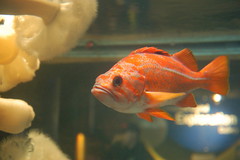 I just acquired my first stabilized camera lens, and I'm impressed so far, especially because it didn't cost me anything. Here's the story.
I just acquired my first stabilized camera lens, and I'm impressed so far, especially because it didn't cost me anything. Here's the story.
Sent for service
Last year I had my relatively new Nikon 18-135 mm zoom lens (designed for the D80 SLR, but bought for my D50) repaired under warranty, after the autofocus became unreliable and the lens housing felt loose. Unfortunately, Nikon's low-end lenses don't seem to stand up especially well to the usual wear and tear of enthusiastic use, because recently I had the same problem again with the same lens: unreliable autofocus and loose feel with the lens mounted on my camera, less than a year after the repair.
(By the way, I have a couple of much older but higher-end Nikon lenses that continue to work flawlessly despite their advanced age and considerable use. The problem is either with the company's more cheaply made lenses or with the particular one I owned.)
Anyway, the lens is covered by Nikon's excellent five-year warranty. So once I sent the zoom in for its second repair, Nikon had a look at it and decided to send me a replacement instead: the newer 18-105 mm VR zoom, introduced with the new D90 SLR a few months ago. While it doesn't zoom in quite as far, the newer lens includes Nikon's vibration reduction system—that's what the VR stands for.
What is vibration reduction?
What Nikon calls vibration reduction (VR), other camera makers call image stabilization (IS) or shake reduction (SR).They're all the same thing. Vibration reduction is a new technology, emerging in commercially available optical devices only in the last ten years. It can be built into the lens (as Nikon and Canon do) or the camera body (as Sony and Pentax do), but both work basically the same way: motion sensors detect the tiny shaky movements you make when hand-holding a camera and compensate for them by moving lens elements (Nikon, Canon) or the camera sensor (Sony, Pentax) with tiny motors.
At slow shutter speeds or long focal lengths, that reduces shake-induced blur in your photos. The technology doesn't make moving subjects (people, vehicles, animals) less blurry, because it can only compensate for things that make the camera vibrate.
The results
But within its limitations, VR works quite well. Take a look:
When using VR, looking through the viewfinder can be a bit strange, because the image you see is steadier than your hands. It's even more noticeable on my dad's image-stabilized binoculars, which magnify the image quite a bit more than my zoom lens, and stabilize both eyepieces. You can feel your hands shaking quite a bit as you look through them, but the image moves in a much more "damped" manner.
The result is great, because both in a camera and through binoculars, you can see more clearly when VR is on. And when you take photos of stationary subjects, you can shoot with shutter speeds one or two stops slower (i.e. taking in only 25% as much light, maybe even less) and still get decently sharp pictures.
It's not the same as having a lens with a wider maximum aperture, or a camera with better low-light sensitivity (ISO), but it's another tool to help make better images.
Labels: cameraworks, geekery, nikon, photography, repairs
17 March 2009
Small victories
There it is: "In what must be the ultimate exercise in navel-gazing, an Austrian scientist has solved the mystery of belly button fluff" (via Brian Chin at the late Seattle Post-Intelligencer).
16 March 2009
A little walk
This is my kids' walk to school—and since I attended the same school in the '70s, it's also the same walk I took each day 30 years ago:
Compiled from 47 photos taken with my Nikon D50 every 15 to 20 steps on the way, and made with iMovie '09. Music is my tune "Camp Walk," from 2006.
Labels: family, memories, movie, nikon, penmachinepodcast, school
15 March 2009
Plus ça change...
Here's our friend Lisa at her wedding yesterday, saying hi to our other friend Christina during the reception dinner:
And here was Lisa in a plaid skirt back in 1992 dancing to my band (a later incarnation of our band also played at the wedding yesterday, by the way):
Other than the wedding dress in one and the early-'90s fashions and hair in the other, she looks the same, 17 years later! I certainly can't say the same for myself.
Thanks to Simon for the '92 picture.
Labels: age, friends, memories, party, wedding
12 March 2009
That rocks
In case you doubt that a mashup can be true art, see here:
Via Big Al.
Labels: mashup, music, video, youtube
11 March 2009
Calling BS on new "high fibre" foods
Noticed how many more prepared food products (yogurt, cookies, ice cream, etc.) are advertising fibre content in the past year or so? Have food makers smartened up and started putting whole grains in a whole bunch of foods? As you would expect, no. The companies are simply able to put artificial fibre additives into a wider variety of foods than they used to. However:
The problem with this is that nobody knows if these fiber additives possess the same health benefits as natural fiber found in whole grains, fruits, and vegetables.
So that new high-fibre yogurt that doesn't taste high-fibre—well, it may not be any better for you than the old stuff, and is very likely not as good for you as real whole-grain food. No shock: these new fibre-enriched foods are more marketing than nutrition.
Labels: food, marketing, science
10 March 2009
Fooling yourself
Back in 1974, Richard Feynman, one of the most famous physicists of the 20th century, gave a commencement address at the California Institute of Technology. He called it "Cargo Cult Science" (PDF). It contains what I think is the best succinct summary of the scientific process:
The first principle is that you must not fool yourself—and you are the easiest person to fool.
Then, he said, "it's easy not to fool other scientists. You just have to be honest in a conventional way after that." The entire structure of science—in universities and journals, online and at symposia, and in the principles of being able to repeat experiments, falsify theories, and predict results—is an attempt to keep from fooling ourselves about reality.
That shows how hard it is to avoid being foolish: scientists and the rest of us still fool ourselves all the time. But the process also does a good job correcting mistakes, so our foolishness doesn't last. As a human system, science isn't perfect, but it does well at refining our knowledge, letting us weed out imperfections in what we understand about our world and universe.
Labels: publicspeaking, school, science
09 March 2009
Excuse me?
I looked out the window this morning and I was actually angry. I don't anger easily, but here's the view now, after I shoveled the walk and driveway and cleared off the car:
This is Vancouver. In March. In contrast, here's what we were doing in your yard in February last year:
Or, for that matter, three weeks ago at the schoolyard:
Even my kids looked out at the snow today and said, "Not again!"
I mean, WTF?
Labels: annoyances, environment, snow, vancouver, weather
08 March 2009
A match of wits
Our problem woodpecker has returned, a month later, and seems undeterred by our protective chimney cages. We thought weather or the bird itself might have disturbed them, but no, they are still firmly in place. So the first move is to make the cages bigger—our Northern flicker may be large enough to get its beak right between the mesh to the metal.
Whenever I've heard the hammering (around 7 a.m., or 8 now that we're in Daylight Saving Time), I've made a quick leap into my bathrobe and slippers and tossed some pebbles from our yard onto the roof, which seems to scare it away each time. But, clever as this bird is, it doesn't seem to learn from the experience. As my dad said, "it's a match of wits." So far, the woodpecker is outwitting us.
Labels: animals, annoyances, biology, vancouver
07 March 2009
Links of interest (2009-03-07):
- The first animals that people domesticated were wolves—we call them dogs now. Coincidentally, within an hour last night I read a Slate article and saw an episode of "Martin Clunes: A Man and His Dogs" on that very topic.
- From Salon: "To this day when I walk into a grocery store and see a mom with her teenage daughters, I have to leave. Every time I just get tearful, I just can't be in the same room, even after all these years. It just kills me that I don't get that time back."
- The Economist makes a compelling argument that all recreational drugs—yes, even hard drugs like heroin and cocaine—should be legalized (via Dan Savage). That's a pretty radical position, but the magazine posits it as the "least bad" option, after "the war on drugs has been a disaster, creating failed states in the developing world even as addiction has flourished in the rich world. By any sensible measure, this 100-year struggle has been illiberal, murderous and pointless."
- Don't forget to put your clocks forward by an hour tonight for Daylight Saving Time, if you're in a part of the world that invokes it early Sunday morning.
- Scanwiches are sandwiches, cut in half and imaged on a flatbed scanner—which I presume needs very frequent and thorough cleaning (via J-Walk).
- New Homestar Runner meta-cartoon: 4 Gregs.
Labels: addiction, animals, animation, family, food, geekery, linksofinterest, science, security, time
06 March 2009
Links of interest (2009-03-06):
- Transom.org has some wonderfully comprehensive audio articles for podcasters, like the stand mic shootout, handheld mic shootout, and recording phone calls tutorial (via Doug Kaye).
- PhotoFunia lets you put your own face into various stock photos (via J-Walk). Some work better than others. A couple of sample pictures of one of my daughters and me:

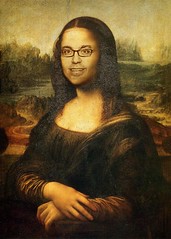
- Mac OS iPhone project (via Melanie). It was bound to happen.
- Photographic shit disturber Ken Rockwell points to these two great posts about film photography from John Sevigny, on the theme of digital cameras: the thrill is gone: "Many of the film oriented products introduced at PMA [this week's big photo tradeshow] are far more interesting than anything digital that bothered to show up to the party. [...] My advice: get [a used Nikon] FM2 for less than $500, three or four lenses for another $500 total, and a 35mm film scanner for another $500. [...] Use the remaining $6,500 to fly to Brazil, China, Mexico or Thailand and spend several months photographing there."
- Isabella and Raul have started organizing Mental Health Camp, an unconference here in Vancouver about mental health issues, April 25, 2009 in Gastown. (UPDATE: It now has its own URL at MentalHealthCamp.org.)
- Remember that crazy Leica R9 SLR camera I blogged about in 2007? Well, Leica long ago stopped making the digital back, and now they're discontinuing the camera and lenses too. But not to worry: an all-digital, autofocus R10 will come eventually. And will be amazingly high-priced, just like its upcoming big sibling the S2.
- Rebecca posts about Rudyard Kipling's visits to Vancouver in the 1800s and early 1900s, and how much our city changed during that time.
- The Onion's "San Francisco Historians Condemn 1906 Earthquake Deniers" is almost as good as the old "Evangelical Scientists Refute Gravity With New 'Intelligent Falling' Theory."
Labels: controversy, film, geekery, history, linksofinterest, mentalhealth, photography, podcast, recording, science, vancouver
05 March 2009
A lightswitch dimmer that fits in the old slot
Inspired by the halogen lights in the hotel rooms we visited last week, my wife and I bought some inexpensive new light fixtures for our kitchen yesterday. Even after swapping the bulbs for lower-wattage versions, we discovered that they can be pretty bright. So today I tracked down a clever dimmer switch, the first of its kind I've seen:
The switch fits in a regular old-style wall plate, the kind we've had throughout our house since it was built in the 1960s. The main toggle is slightly narrower than usual, and operates the regular way. Next to it is a tiny, thin, fingernail-operated slider that operates the dimmer. Neat.
Whenever we repair or repaint something in the house, it becomes suddenly obvious how old and dirty some of the unchanged stuff is. In this case, the beige old wall plate and switch make it clear not only how not white they are, but how grimy the switch itself is after over 40 years of use. Ew.
Labels: home, homedepot, repairs
04 March 2009
Another goldfish commercial
I'd forgotten yesterday that my friend Adam Woodall appeared in not one but two Goldfish Cracker commercials a few years ago. Here's the second one. No orange powder this time:
Labels: band, friends, humour, music, television
03 March 2009
Adam Woodall on Virgin Radio Vancouver
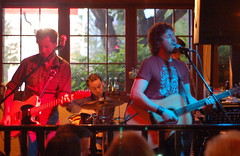 My friend and sometime co-musician Adam Woodall has been part of the music scene here in Vancouver for over 15 years, and he's finally getting some radio play: his song "Coming Home Soon" from the 2006 Adam Woodall Band album Silver Ring.
My friend and sometime co-musician Adam Woodall has been part of the music scene here in Vancouver for over 15 years, and he's finally getting some radio play: his song "Coming Home Soon" from the 2006 Adam Woodall Band album Silver Ring.
Virgin Radio DJ Buzz Bishop has posted his interview with Adam online. Give it a listen to hear about Adam and the AWB, and for a couple of mean live solo acoustic versions of "Coming Home Soon" and "Hit Me Baby One More Time" (yes!).
Don't forget to check out Adam's YouTube harmonica lessons too. He's not only a great singer and a tasteful and talented guitarist, but an awesome harmonica player. In fact, the first time I ever met Adam back around 1994 or so, I got his business card, and all it said was "Adam Woodall - Harmonica."
Finally, if you're wondering about his appearance in the Flavor-Blasted Goldfish commercial, here it is:
Adam's on the left. Yes, he really did get coated in orange powder for that.
Labels: band, friends, music, radio
02 March 2009
End of an era
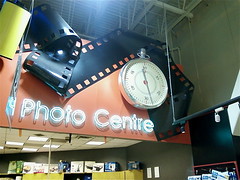 Today I brought some rolls of black-and-white film photos, which I'd taken at Northern Voice and our vacation last week, to the Save-On-Foods one-hour photo lab at Metrotown in Burnaby. Since the film was not regular silver halide B&W, but the kind that can be processed in a colour print minilab, Save-On developed, printed, and scanned the pictures in an hour.
Today I brought some rolls of black-and-white film photos, which I'd taken at Northern Voice and our vacation last week, to the Save-On-Foods one-hour photo lab at Metrotown in Burnaby. Since the film was not regular silver halide B&W, but the kind that can be processed in a colour print minilab, Save-On developed, printed, and scanned the pictures in an hour.
But at the end of the week, Save-On is shutting down its one-hour lab. That's the end of an era for me—I've been having film developed, as well as both film and digital pictures printed there, for about 20 years. It's a sign. Hardly anyone but photo enthusiasts uses film anymore. Since I started shooting film again last summer, I've hardly ever seen anyone else bringing film into the Save-On lab. Usually the attendant is reading a book.
There are plenty of other options nearby, including the inexpensive Costco one-hour lab down the hill, the nearby London Drugs, and maybe one or two in the mall. There are also numerous proper pro labs in the city that will process and print nearly any kind of film with loving care—and for a price. But I'll miss the corner of Save-On with its now-outdated big-ass sign featuring a giant model film roll and 60-minute stopwatch.
Labels: film, geekery, history, photography, vancouver
01 March 2009
Deep bathtubs and the sound of surf
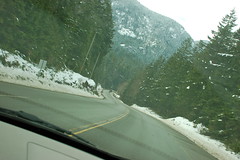 I still have some more photos to upload, but early this evening we got back home after seven and a half hours and nearly 300 km by car and ferry returning from Tofino and Parksville. It was a great trip, one that will leave memories. As a nice capper, we managed to meet up with my friend Simon on the ferry in Nanaimo and, once we crossed the water, gave him a ride into West Vancouver to visit his family.
I still have some more photos to upload, but early this evening we got back home after seven and a half hours and nearly 300 km by car and ferry returning from Tofino and Parksville. It was a great trip, one that will leave memories. As a nice capper, we managed to meet up with my friend Simon on the ferry in Nanaimo and, once we crossed the water, gave him a ride into West Vancouver to visit his family.
We live in a huge part of the world. I mean huge oceans, huge mountains, huge trees, huge birds, huge beaches, and huge distances. At highway speeds (except for the really twisty parts, and lunch), it took us three hours to drive in the rain about half the way, across one of the narrowest parts of Vancouver Island. It's apparently a faster trip right across Ireland. We passed between snow-blanketed mountains 1400 m high—taller than any in Britain, to make another cross-Atlantic island comparison.
It's common for us British Columbians to take day trips or short vacations over distances that would cross several countries in Europe, as my family did this week. I'm glad to be home, but as I noted on on Twitter, I miss the huge, deep, comfortable hotel bathtubs. And the heated tile floor in Tofino. And the sound of surf, gentle or roaring.
Labels: animals, canada, europe, family, friends, memories, oceans, travel
